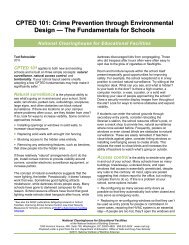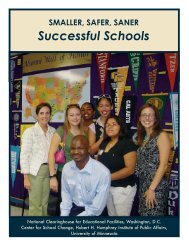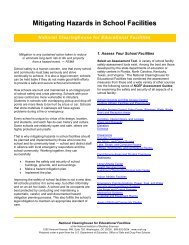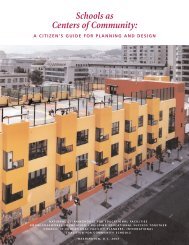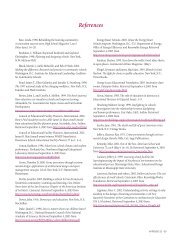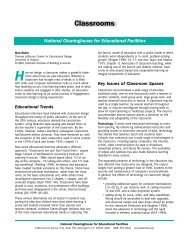A History of School Design and its Indoor - National Clearinghouse ...
A History of School Design and its Indoor - National Clearinghouse ...
A History of School Design and its Indoor - National Clearinghouse ...
Create successful ePaper yourself
Turn your PDF publications into a flip-book with our unique Google optimized e-Paper software.
A <strong>History</strong> <strong>of</strong> <strong>School</strong> <strong>Design</strong> <strong>and</strong> <strong>its</strong> <strong>Indoor</strong> Environmental St<strong>and</strong>ards, 1900 to Today<br />
55 for Human Thermal Comfort (ASHRAE, 2010a). It has<br />
coincided with a design trend towards reconsidering the<br />
possibilities <strong>of</strong> ventilating classrooms naturally (or with<br />
mixed-mode systems), to which signifi cant research is<br />
now being conducted (Kwok & Chun, 2003; Mumovic et<br />
al., 2009).<br />
6.2.2 Lighting<br />
Although illumination st<strong>and</strong>ards for classrooms have<br />
largely leveled <strong>of</strong>f in recent years, there is still some<br />
disagreement about even the most basic question <strong>of</strong><br />
how much illumination is necessary in classrooms. For<br />
example, the current ASHRAE Advanced Energy <strong>Design</strong><br />
Guide, which is supported by IESNA (the former Illumination<br />
Engineering Society is now called the Illumination<br />
Society <strong>of</strong> North America), advocates for anywhere between<br />
30 <strong>and</strong> 70 footc<strong>and</strong>les for classroom spaces, while<br />
the IESNA guidelines for classrooms still use 50-100<br />
footc<strong>and</strong>les as a guideline (Wu & Ng, 2003). Still, this<br />
disagreement is largely overshadowed by other concerns<br />
regarding quality <strong>and</strong> distribution <strong>of</strong> light, as well as specifi<br />
c issues in daylighting design. Contemporary research<br />
<strong>and</strong> thought regarding lighting in classrooms has largely<br />
focused on the need for performance-based st<strong>and</strong>ards<br />
that accurately represent both illumination <strong>and</strong> visual<br />
comfort metrics. There has been considerable debate<br />
about the appropriate metrics for daylighting in particular,<br />
as the industry has moved back towards the desire for<br />
naturally lit spaces (Mardaljevic et al., 2009).<br />
Research on lighting in classrooms in the past 20 years<br />
has also had a signifi cant impact on practice, since a<br />
resurgence <strong>of</strong> fi ndings in the value <strong>of</strong> natural light have<br />
emerged. For example, one study in 1992 looked at cortisol<br />
(a hormone) production <strong>and</strong> concentration abilities<br />
in students without access to natural light, <strong>and</strong> found that<br />
natural light was positively correlated with this important<br />
hormone (Kuller <strong>and</strong> Lindsten, 1992). They noted that<br />
this research had been re-engaged due to research in<br />
the 1980s regarding natural light <strong>and</strong> recovery times in<br />
healthcare environments (Ulrich, 1984). Then in 1999,<br />
the Heschong Mahone Group published their <strong>of</strong>t-cited<br />
study on daylighting in classrooms. This study can certainly<br />
be credited with having had a signifi cant impact on<br />
the industry, as it was one, if not the, major study cited to<br />
support the notion that high-performance school buildings<br />
can have a positive impact on student learning.<br />
<strong>National</strong> <strong>Clearinghouse</strong> for Educational Facilities<br />
a program <strong>of</strong> the <strong>National</strong> Institute <strong>of</strong> Building Sciences<br />
1090 Vermont Avenue, N.W., Suite 700, Washington, DC 20005-4950 202-289-7800 www.ncef.org © 2012, <strong>National</strong> Institute <strong>of</strong> Building Sciences<br />
23<br />
Recent years have seen increasingly convincing studies<br />
on the importance <strong>of</strong> daylighting, hopefully building<br />
a more reliable body <strong>of</strong> literature to support this practice<br />
(see Figuero <strong>and</strong> Rea 2010 for an example <strong>of</strong> this new<br />
research). Still, the major barrier remains that while<br />
expert lighting designers <strong>and</strong> researchers have a sense<br />
<strong>of</strong> what a good visual environment should look like, <strong>and</strong><br />
how one might measure these lighting <strong>and</strong> daylighting<br />
phenomena, no simple st<strong>and</strong>ard has yet been developed<br />
to clearly specify the performance st<strong>and</strong>ards needed for<br />
the industry to respond accordingly. As such, the past<br />
two decades have produced many school buildings with<br />
suffi cient natural light but little attention to issues <strong>of</strong> visual<br />
comfort <strong>and</strong> glare. Initial research fi ndings are indicating<br />
that occupant comfort is <strong>of</strong>ten sacrifi ced in these spaces,<br />
but more research is needed to corroborate this fi nding<br />
(Baker, 2010).<br />
6.2.3 Acoustics<br />
Research conducted in the 1980s <strong>and</strong> 1990s greatly<br />
contributed to industry underst<strong>and</strong>ing <strong>of</strong> the necessity <strong>of</strong><br />
good acoustical conditions in classrooms. These papers,<br />
which covered the importance <strong>of</strong> low background noise<br />
level, speech intelligibility <strong>and</strong> the avoidance <strong>of</strong> sites with<br />
periodic acoustic disruptions (sites near airports, train<br />
lines, etc) helped to identify not only that acoustics mattered,<br />
but also the appropriate thresholds for acoustical<br />
st<strong>and</strong>ards (Berg et al., 1996; Cr<strong>and</strong>ell & Smaldino, 1995;<br />
Evans & Maxwell, 1997).<br />
These studies all contributed to the launching <strong>of</strong> ANSI<br />
St<strong>and</strong>ard 12.60 in 2002, a st<strong>and</strong>ard written by the Acoustical<br />
Society <strong>of</strong> America, which has since been adopted<br />
into the LEED st<strong>and</strong>ards for school buildings <strong>and</strong> a variety<br />
<strong>of</strong> other related performance st<strong>and</strong>ards for buildings<br />
(Acoustical Society <strong>of</strong> America (ASA), 2009; Kurtz et al.,<br />
2009). This st<strong>and</strong>ard calls for a maximum background<br />
noise level <strong>of</strong> 35 dBa in st<strong>and</strong>ard classrooms, with reverberation<br />
times between 0.6 <strong>and</strong> 0.7 seconds, along<br />
with guidance <strong>and</strong> specifi cations for Sound Transmission<br />
Class ratings for exterior <strong>and</strong> interior wall assemblies,<br />
<strong>and</strong> Impact Insulation Class ratings to address fl oor-t<strong>of</strong>l<br />
oor noise transmission. It is considered to be a very<br />
comprehensive st<strong>and</strong>ard, <strong>and</strong> is the fi rst <strong>of</strong> <strong>its</strong> kind for<br />
any typical building space type (there is no such st<strong>and</strong>ard<br />
for <strong>of</strong>fi ce buildings, hospitals or other similar spaces,<br />
although some <strong>of</strong> these st<strong>and</strong>ards are in development).



